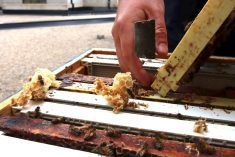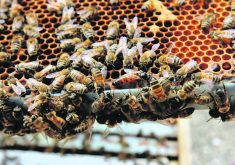The cool weather so far this summer could deliver a double hit to Manitoba‘s honey producers.
Besides depressing honey yields, it could also weaken bee populations going into the winter.
That would be the last thing Manitoba beekeepers need after experiencing record honeybee losses in 2008-09.
“There is a lot of concern unless we get some really nice weather,” said provincial apiarist Rheal Lafreniere.
Cool conditions have put the honey flow about three weeks behind normal. The first round of honey extraction began near the end of July and “is certainly not breaking any records,” said Lafreniere.
Read Also

Pig transport stress costs pork sector
Popular livestock trailer designs also increase pig stress during transportation, hitting at meat quality, animal welfare and farm profit, Agriculture and Agri-Food Canada researcher says
“Unless August turns out to be an absolutely phenomenal month for honey production, it is very doubtful that we will achieve average production.”
Average honey production in Manitoba is 165 pounds per colony. Production in the last two years was close to average.
There’s lots of opportunity left to make up for lost time. Lafreniere said a staggered canola bloom could continue well into August. Delayed haying means alfalfa crops are going into bloom, giving bees another foraging option.
“If we do get some nice weather, there’s a lot of forage for them.”
But time is running out for an average honey crop. Lafreniere said the flow usually ends around August 20, although a warm spell could extend it into early September. If cool weather continues into late summer, bees will stop foraging and may not have enough food supplies to last them through the winter, he said.
Shutting colonies down too early is also risky because it plugs up brood space and crowds out room for queen bees to lay eggs for the next generation of bees to survive over winter, he said.
That’ll mean fewer young bees and, potentially, lower honeybee populations going into 2010.
That would be serious for Manitoba producers still battling high winter losses from 2009, said Lafreniere.
The province’s beekeepers lost nearly a third of colonies that were overwintered, according to surveys. Reported colony losses were 32 per cent in Manitoba and even higher in some other provinces (44 per cent in Alberta, 43 per cent in New Brunswick and 40 per cent in Prince Edward Island).
The national rate of colony loss was just over 34 per cent, marking the second straight year of high honeybee losses across Canada. Bees either died off over the winter or were too weak in spring to be viable.
Honeybee losses in the United States were marginally lower at 29 per cent, after reported losses of 36 per cent in 2008 and 31.2 per cent in 2007.
The rate of bee losses is far higher than normal. Long-term average winter losses in Manitoba typically range between 15 and 25 per cent.
The recent high losses, especially in the U. S., have been blamed on a phenomenon known as Colony Collapse Disorder, in which bees mysteriously go missing from hives.
But the latest surveys show only 15 per cent of U. S. losses can be directly linked to CCD. Scientists now believe the loss of bees is likely due to multiple problems, such as mites, diseases, weak queens, poor weather and starvation.
Even so, the U. S. Environmental Protection Agency has established a multi-disciplinary Pollinator Protection Team to investigate the causes of CCD.
The team has developed a strategic plan to advance pollinator protection. It’s estimated three-quarters of the plants on earth require pollination. [email protected]


















